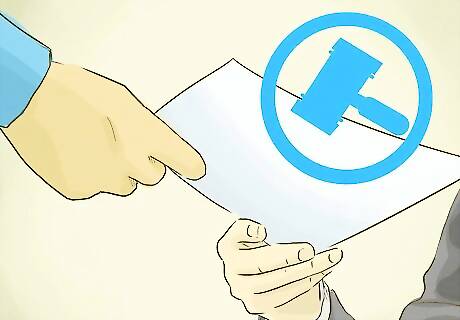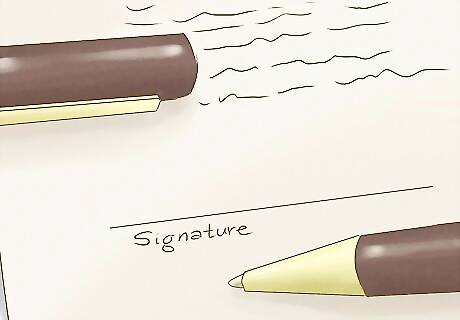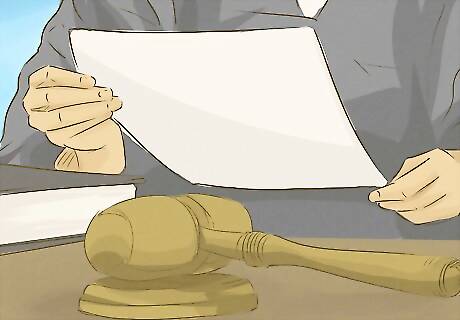
views
X
Research source
Outside of small claims, it is possible to file a lawsuit in state or federal court without an attorney, although as your case progresses or if things become more complex – and especially if the other side lawyers up – you should consider bringing on a licensed attorney to help represent your interests.
Filing in Small Claims Court

Make sure your claim falls within the court's limits. Small claims courts are courts of limited jurisdiction, so you cannot ask for more than the maximum amount the court has the power to order. The court also must have personal jurisdiction, which means it must have the power to order the person you're suing to pay you money if you win. Typically this means you need to sue in the county where the person you're suing lives. Check as well to make sure that the type of case you have is one decided in small claims. Even if the monetary amount is small, it may not fit within the court's limits. The limit typically is between $3,000 and $10,000, but that's a broad range. For example, the limit for small claims is $5,000 in New York, but $10,000 in California. Also keep in mind that small claims courts generally don't decide divorce, guardianship, custody, or estate matters, nor do they provide equitable remedies.

Check the statute of limitations for your claim. Statutes of limitations provide a deadline after which you aren't allowed to sue someone, even if they wronged you.

Get the forms you need. Most states provide a simple form you can fill out for a small claim.

Fill out your forms. Follow the formatting rules of your court as laid out on the form. For example, many jurisdictions require you either to type out your information or to print using blue or black ink. Make sure all the information you're telling the court is true and correct, and that you have the full legal name of the person or business you're suing.

Sign your forms. You must sign and date your forms before the court will hear your claim. Once you've signed your forms, make at least two copies: one for your records and one for the person you're suing. The court will keep the originals when you file them.

File your forms with the small claims court clerk. Once you've signed your forms, take the original and your copies to the clerk of court's office for filing. You'll have to pay a fee when you file your forms, usually under a hundred dollars. If you can't afford the fee, you may be able to make a request to have the fee waived. You probably will have to provide information about your financial status including your income and assets.

Have the forms served on the other side. To have a trial, the person you're suing has to have sufficient legal notice that you're suing him. In small claims cases, the clerk may arrange service for you through the sheriff's department for a small fee. The sheriff's department then files the proof of service the court needs to ensure the trial is fair. If you're responsible for service, you can't do it yourself, but you can get anyone over 18 who isn't involved in your case to do it for you. They will have to sign the proof of service form, which you will have to file. You also can contact the sheriff's department yourself, or use a private process serving company.

Appear in court on your appointed date. Many jurisdictions simply assign you a trial date when you file a small claim, so if you don't show up on that date, you lose your case. Some jurisdictions add a "first appearance" date that you don't need to show up for, only the person you're suing does. If this is the case in your state, the clerk will let you know. When you appear, dress in clean, conservative clothing and treat all court staff including the judge with respect and courtesy. Check with the court before you go to make sure you've left any prohibited items such as pocket knives or cell phones at home. Bring any documents or witnesses you need, but keep everything organized so you won't disrupt the court looking for something.
Filing in State Court

Communicate with the other side to attempt to resolve the dispute. Think of filing a lawsuit as a last resort. Anything you can do to resolve your dispute before resorting to litigation will save a lot of time, money, and stress for all involved.

Make sure you've chosen the right court. Many states have separate courts, each with their own limited jurisdiction. For example, probate courts deal with wills, trusts, and estate matters. Family courts deal with family law issues such as divorce and child custody. Beyond those special courts, the general civil court can only hear your claim if it has personal and subject matter jurisdiction – meaning it has the power to order the person you're suing to do something related to the subject of your lawsuit. To have personal jurisdiction, the court generally must be the located in the county where the person you're suing lives, or where a company does business.

Check the statute of limitations for your claim. States only gives you a certain amount of time to file a lawsuit over something, so you should check before you file your suit to make sure that deadline has not passed.

Familiarize yourself with the court's rules of evidence and civil procedure. You may not have gone to law school or passed the bar exam, but if you represent yourself the judge expects you to know the rules to the same extent as the attorneys who have.

Search for forms or instructions. Many states have form petitions available for common types of cases. These forms are pre-approved by the courts and include all the necessary information to state a claim. Typically these forms include instructions for filling them out, along with basic formatting instructions. For example, you usually aren't allowed to change the formatting of the form itself, such as by retyping it yourself. If you print the form and handwrite your answers, most courts expect you to print legibly using blue or black ink. You also should find out if there are any other forms you need to include along with your complaint or petition. Typically you will need a summons or a certificate of service. You also may need a cover sheet or other documents such as a notice of hearing.

Pull together necessary documents and information. Before you start working on the documents you're going to file with the court, take a moment and make sure you have all the correct information to include in them. Double-check the name of the person or business you want to sue and make sure you've got a full legal name. For example, if you file a lawsuit against "Bob Jones," but the man's legal name is "Robert Jones," he can effectively ignore your lawsuit.

Fill out the applicable forms or draft your complaint. If you couldn't find a form for your particular claim, you may be able to find a similar case previously filed in the same court that you can use as a guide.

Take advantage of self-help resources. In addition to online resources, many courts have self-help centers at the courthouse, or clinics that meet a few times a month. Attorneys at these centers or clinics can review your forms or even offer you limited legal advice on your claim free of charge, as well as walk you through the process of filing a claim and help you better understand your state's rules of evidence and civil procedure.

Sign your documents. You must sign your complaint or petition before you can file it. In some cases you also must sign it before a notary public, or include an affidavit signed before a notary. If you don't know where to locate a notary, call your bank. Many banks offer notary services to their customers free of charge. You also can find a notary at the courthouse or in a private business such as a check-cashing company, although you'll have to pay them a small fee. After you've signed your documents, make enough copies to have one for your own records plus one for each person you're suing – the court keeps the originals.

File your complaint with the appropriate clerk of court. Once you've completed your complaint and any other documents, take the entire packet together with any copies to the clerk's office. You'll have to pay a fee to initiate your lawsuit, which can be as much as several hundred dollars. If you can't afford the fees, ask the clerk for a form to request a waiver. You probably will have to provide information about your income and assets before the judge will approve your request.

Have the other side served. Before the court will hear your case, the other side must know that you are suing them, and for what. Having them served through a judicially accepted process provides this notice. Typically you can have the lawsuit served personally by the sheriff's department or a private process serving company. You also may be able to use certified mail in some courts. You also can get anyone over the age of 18 who isn't involved in your case to deliver the papers to the other side, if you know someone trustworthy who is willing to do so. If you go this route, give the person your proof of service form so they can fill it out and sign it once they've completed service.

File your proof of service. If you use the sheriff's department or a private process serving company, they typically will file the proof of service on your behalf. However, if you have the papers served on your own, you must file a document letting the court know the lawsuit was served on the other party.
Filing in Federal Court

Exhaust all other remedies before going to court. In many federal cases, you are required to file a complaint or charge with a federal agency before filing suit in federal court. Some federal agencies such as the Equal Employment Opportunity Commission require you to go through the agency's administrative procedures first. If the administrative investigation closes with no resolution, you receive a notice of your right to sue and you can file a suit in federal court.

Make sure you've chosen the right court. Federal courts must have personal and subject matter jurisdiction before they can hear a case. This means the court must have the power to order the person you're suing to do something related to a claim the court also has power to decide. Federal courts generally can hear cases involving federal laws, or involving residents of different states. Typically, you must file your lawsuit in the federal court that has personal jurisdiction over the person you're suing. Check the federal districts to find the district court that covers her county.

Check the statute of limitations for your claim. The statute of limitations provides a deadline beyond which you can't file a claim. This period of time normally begins the moment the event happened that serves as the basis for your lawsuit. If the deadline passes, the court will dismiss your case.

Familiarize yourself with the federal rules of evidence and civil procedure, as well as the local rules of the court where you'll file your case. If you decide to proceed without an attorney, the judge will still expect you to know all of the applicable rules.

Download the proper forms and instructions. Each district court has a pro se manual, which may include forms and instructions for a basic complaint. Federal courts require you to file a cover sheet, a complaint, and a summons to initiate your lawsuit.

Gather the information you need. Before you start filling out forms or drafting your complaint, make sure you have all the information you'll need to tell the court about your claim. If you are suing a business, you should double-check to make sure you have its correct legal name. For example, if you put "Sally's Seashell Company" when the legal name of the company is "Seashells by the Seashore," Sally can get your lawsuit dismissed. If you have any other documents that support your claim, make copies of them so you can include them with your complaint.

Fill out your cover sheet. The cover sheet provides the court with basic information of your claim. It's a good idea to fill it out first so it can provide you with an outline of your complaint. Where the cover sheet asks for the name and contact information of the attorney handling the case, you should put in your own name and contact information since you're acting as your own attorney. After basic information about the parties, the cover sheet requires you to indicate the basis of jurisdiction for your case, the nature of your lawsuit, and the amount of damages or other relief you're requesting the court order.

Draft your complaint. Follow the instructions in the pro se handbook to draft your complaint using federal rules and the district's local rules. Make sure you use plain white paper and either type or print legibly using blue or black ink. Your complaint, and every other document you file with the court in your case, will have a caption on the top of the first page that identifies the court, the parties in the case, the case number, and the title of the document. Since this is your first pleading, however, you don't yet have a case number. If you choose to include evidence to support your claim, attach those documents and reference them in your complaint as exhibits. For example, if you have an employment discrimination claim, you might include the notice of right to sue that you received from the EEOC as an exhibit.

Draft your summons. The summons tells the person you are suing that you are filing a lawsuit against them and they must answer the lawsuit within a certain period of time. Make sure you include the name of the person or business you're suing and a correct address. Since the summons will be sent to the defendant, make a copy of it before you file it if you want one for your records.

Sign your documents. You must sign your documents in blue or black ink and date them before the court will accept your complaint. The federal rules don't require any further verification such as signing in front of a notary, or any additional affidavits. Once you've signed everything, make at least one copy of the whole packet for your own records and another copy for each person you're suing.

File your documents. Take your originals and your copies to the clerk's office to file your lawsuit. You also can send in your documents and file your initial papers by email. You'll have to scan in your signed documents and send them to the email address provided in your pro se manual. You'll have to pay a filing fee of $400 to initiate your lawsuit in federal court. If you can't afford the filing fee, you can file a form asking the court to waive the fees in your case. You'll have to provide the court with proof that you have limited income and assets.

Have the other side served. After you've filed your lawsuit, you have to notify the other side about it using a legal process server before the court will hear the case. You may use the U.S. marshal to serve your federal lawsuit, or you can use a private process serving company. You also may be able to use certified mail.

File your proof of service. After you've served the other side, you must file a proof of service lettering the court know that the other side knows about the lawsuit.



















Comments
0 comment